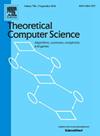Smaller kernels for 3-leaf power modifications problems
IF 0.9
4区 计算机科学
Q3 COMPUTER SCIENCE, THEORY & METHODS
引用次数: 0
Abstract
A graph G is a 3-leaf power if there is a tree T and a bijective mapping f from to the set of leaves of T such that if and only if the distance in T between and is at most 3 for every distinct . In the 3-Leaf Power Vertex Deletion (resp., 3-Leaf Power Completion) problem the input is a graph G and an integer k, and the goal is to decide whether G can be transformed into a 3-leaf power graph by deleting at most k vertices (resp., adding at most k edges). In this paper we give a kernel for 3-Leaf Power Vertex Deletion with vertices and a kernel for 3-Leaf Power Completion with vertices. Our results improve the previous -vertices kernel for 3-Leaf Power Vertex Deletion [Ahn et al., 2023 [3]] and the -vertices kernel for 3-Leaf Power Completion [Bessy et al., 2010 [5]].
3叶功率修正问题的更小的核
一个图G是一个三叶幂,如果有一个树T和一个从V(G)到T的叶集合的射映射f,使得(u, V)∈E(G)当且仅当T中f(u)和f(V)之间的距离对于每个不同的u, V∈V(G)不大于3。在三叶幂顶点删除(3-Leaf Power Vertex Deletion)中。(3-Leaf Power Completion)问题,输入是一个图G和一个整数k,目标是通过删除最多k个顶点来决定G是否可以转换成一个3-Leaf Power graph。(最多添加k条边)。本文给出了O(k6)个顶点的3叶幂顶点删除核和O(k2)个顶点的3叶幂补全核。我们的结果改进了之前用于3叶功率顶点删除的O(k14)顶点核[Ahn等人,2023[3]]和用于3叶功率补全的O(k3)顶点核[Bessy等人,2010[3]]。
本文章由计算机程序翻译,如有差异,请以英文原文为准。
求助全文
约1分钟内获得全文
求助全文
来源期刊

Theoretical Computer Science
工程技术-计算机:理论方法
CiteScore
2.60
自引率
18.20%
发文量
471
审稿时长
12.6 months
期刊介绍:
Theoretical Computer Science is mathematical and abstract in spirit, but it derives its motivation from practical and everyday computation. Its aim is to understand the nature of computation and, as a consequence of this understanding, provide more efficient methodologies. All papers introducing or studying mathematical, logic and formal concepts and methods are welcome, provided that their motivation is clearly drawn from the field of computing.
 求助内容:
求助内容: 应助结果提醒方式:
应助结果提醒方式:


